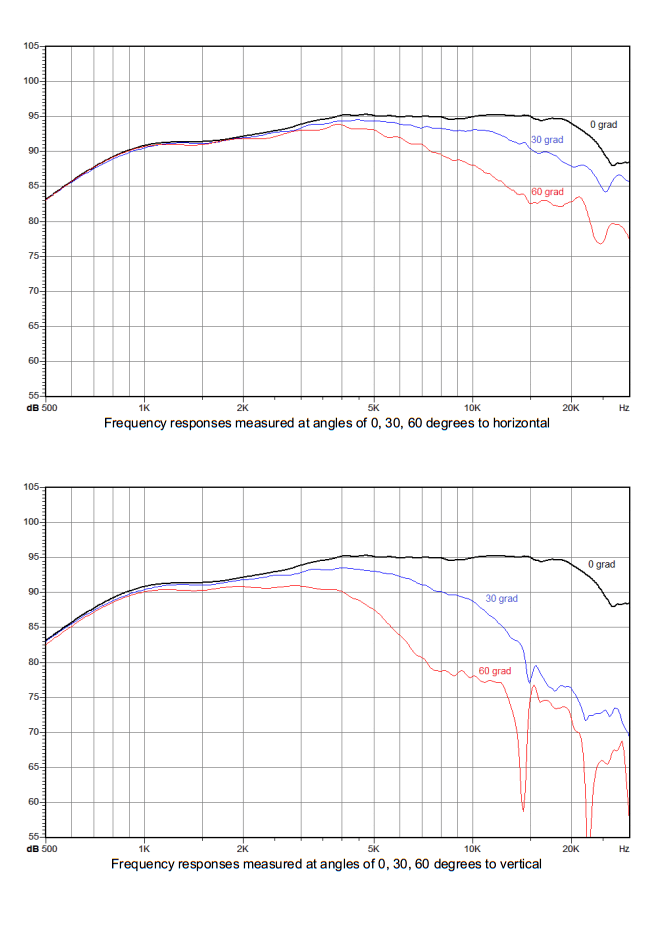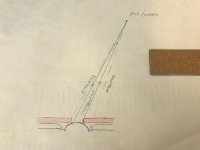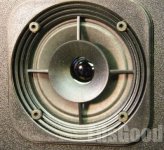So we know that with diaphragms undergoing pistonic movement, the radiation pattern transitions from spherical/hemispherical to something that looks more like a beam as the frequency increases. The reason for this is because as the wavelength shortens, the sound waves produced at different areas of the diaphragm start to destructively interfere (combine out of phase) at the listening/measuring point, instead of constructively as they would at longer wavelengths.
What if we reduced or blocked the output from one part of the piston (in this case a dome tweeter) so that only a smaller portion would radiate to the point of interest? In theory, this would increase the frequency at which the dome would start to beam. One way to do this would be to put a thick sheet of felt over the dome, almost in contact with it, but with a small circular hole right over the tip of the dome. The portion of the dome visible through the hole would radiate as normal, as long as the listening/measuring angle was not occluded by the periphery of the hole, but all the other parts of the dome would not be able to contribute their sound energy.
So, this should work to improve off-axis response at high frequencies, but we've done nothing but turn one dome tweeter into a smaller dome tweeter, which is hardly better than selecting a smaller dome tweeter to begin with. The major downside we have now, though, is that the surface area has been significantly reduced which in turn reduces the peak displacement of the dome. This means that we now have less clean output at the low end of the dome's passband. How to get around this? Use a thinner sheet of felt, so that low frequencies (which constructively interfere) are less attenuated, while high frequencies (which generally interfere destructively) are more attenuated. One can imagine that there is a sweet spot, or sweet "range" of thicknesses that may be suitable for this application.
The end result is a dome tweeter that has perhaps a negligible drop in sensitivity at the low end of the passband, a slight drop in sensitivity in the midrange, and a significant drop in sensitivity at the top end of the passband, but with a significantly improved off-axis dispersion at the top. Easily solved with EQ, and the nice thing is, the tweeter is unlikely to thermally overload under normal SPLs since the spectral distribution of energy in almost all kinds of music drops with increasing frequency above 300-500 Hz. Off-axis dispersion is more important in near- and mid-field listening, which comparatively requires less power as well. Excursion is a moot point since the the whole point is to select a felt thickness that hardly attenuates the frequencies where dome displacement is critical.
Unfortunately, all of the above is purely my conjecture... I would love for anyone to put this to the test. I'll even pay for the felt!
What if we reduced or blocked the output from one part of the piston (in this case a dome tweeter) so that only a smaller portion would radiate to the point of interest? In theory, this would increase the frequency at which the dome would start to beam. One way to do this would be to put a thick sheet of felt over the dome, almost in contact with it, but with a small circular hole right over the tip of the dome. The portion of the dome visible through the hole would radiate as normal, as long as the listening/measuring angle was not occluded by the periphery of the hole, but all the other parts of the dome would not be able to contribute their sound energy.
So, this should work to improve off-axis response at high frequencies, but we've done nothing but turn one dome tweeter into a smaller dome tweeter, which is hardly better than selecting a smaller dome tweeter to begin with. The major downside we have now, though, is that the surface area has been significantly reduced which in turn reduces the peak displacement of the dome. This means that we now have less clean output at the low end of the dome's passband. How to get around this? Use a thinner sheet of felt, so that low frequencies (which constructively interfere) are less attenuated, while high frequencies (which generally interfere destructively) are more attenuated. One can imagine that there is a sweet spot, or sweet "range" of thicknesses that may be suitable for this application.
The end result is a dome tweeter that has perhaps a negligible drop in sensitivity at the low end of the passband, a slight drop in sensitivity in the midrange, and a significant drop in sensitivity at the top end of the passband, but with a significantly improved off-axis dispersion at the top. Easily solved with EQ, and the nice thing is, the tweeter is unlikely to thermally overload under normal SPLs since the spectral distribution of energy in almost all kinds of music drops with increasing frequency above 300-500 Hz. Off-axis dispersion is more important in near- and mid-field listening, which comparatively requires less power as well. Excursion is a moot point since the the whole point is to select a felt thickness that hardly attenuates the frequencies where dome displacement is critical.
Unfortunately, all of the above is purely my conjecture... I would love for anyone to put this to the test. I'll even pay for the felt!
Phillips did this 25 years ago. Seas still does it to some degree.
https://www.ebay.com/i/251020596882...MIhIPl-bvD5gIVx0XVCh3M2gMlEAQYAyABEgL9S_D_BwE
https://www.ebay.com/i/251020596882...MIhIPl-bvD5gIVx0XVCh3M2gMlEAQYAyABEgL9S_D_BwE
Yes that's an old and working trick. Other way to do it from Sonus Faber. Dimple dome and ring radiators are done for the same reason.

Discussion thread The Advantages of a Ring Radiator vs. Conventional Domes? (Concave/Convex)
Discussion thread The Advantages of a Ring Radiator vs. Conventional Domes? (Concave/Convex)
That’s just a phase shield... yes, it works but I feel as though it is less effective than restricting output to the very center. I guess some math is in order now!Phillips did this 25 years ago. Seas still does it to some degree.
https://www.ebay.com/i/251020596882...MIhIPl-bvD5gIVx0XVCh3M2gMlEAQYAyABEgL9S_D_BwE
Dimple domes and ring radiators are just to improve breakup. Their off-axis response tend to be worse than those of domes of the same approximate size.Yes that's an old and working trick. Other way to do it from Sonus Faber. Dimple dome and ring radiators are done for the same reason.

Discussion thread The Advantages of a Ring Radiator vs. Conventional Domes? (Concave/Convex)
OK, when I reread, your suggestion is something like slot loaded tweeter - or compression driver without horn (like some supertweeters)?

Then trouble comes when wavelength gets "too" short, above 10-15kHz. The other trouble comes below 3-4kHz and high spl requirement (without horn)
A small 20mm dome or inverted dome tweeter has wide radiation in audible range up to 20kH. But what do you say about Viawave SRT-7? Review of the Viawave SRT-7 ribbon tweeter | HiFiCompass


Then trouble comes when wavelength gets "too" short, above 10-15kHz. The other trouble comes below 3-4kHz and high spl requirement (without horn)
A small 20mm dome or inverted dome tweeter has wide radiation in audible range up to 20kH. But what do you say about Viawave SRT-7? Review of the Viawave SRT-7 ribbon tweeter | HiFiCompass

Last edited:
This is what I mean.OK, when I reread, your suggestion is something like slot loaded tweeter - or compression driver without horn (like some supertweeters)?

Then trouble comes when wavelength gets "too" short, above 10-15kHz. The other trouble comes below 3-4kHz and high spl requirement (without horn)
A small 20mm dome or inverted dome tweeter has wide radiation in audible range up to 20kH. But what do you say about Viawave SRT-7? Review of the Viawave SRT-7 ribbon tweeter | HiFiCompass

Attachments
I misread your description somewhat.
What you are referring to is the AR "Bee Butt".
http://www.classicspeakerpages.net/IP.Board/uploads/post-101650-1137179013.jpg
The yellow stuff is fiberglass which is positioned to stop the comb filtering notches in the off axis response. There is some black felt in the center, but it does more or less nothing.
What you are referring to is the AR "Bee Butt".
http://www.classicspeakerpages.net/IP.Board/uploads/post-101650-1137179013.jpg
The yellow stuff is fiberglass which is positioned to stop the comb filtering notches in the off axis response. There is some black felt in the center, but it does more or less nothing.
Very interesting. Do you have any further info on that, especially frequency response with/without the treatment?I misread your description somewhat.
What you are referring to is the AR "Bee Butt".
http://www.classicspeakerpages.net/IP.Board/uploads/post-101650-1137179013.jpg
The yellow stuff is fiberglass which is positioned to stop the comb filtering notches in the off axis response. There is some black felt in the center, but it does more or less nothing.
EDIT: Found the page that had that photo. Apparently it is a mid, not a tweeter.
Yes, its a midrange, but that doesn't change anything about the physics.
AR originally used it in the AR3a. This was due to the use of a small 0.75" dome tweeter which had to be crossed over fairly high. They needed to use the 2" midrange dome up quite high to get enough high frequency output. Even then, the speaker's power response was quite rolled off above 8kHz. There was some degree of overlap between the midrange and tweeter if I recall.
In the AR303 that we did, the crossover was 5kHz I believe, but there was no overlap. We used the ring to make sure that the 2" dome had very flat power response up to the crossover frequency. We didn't really need to do that, but at least 50% of the entire design was to not deviate too much from features that the original product had.
I don't think any of the original measurement data exists anymore, but from memory the ring made the driver flat off axis out to about 8kHz.
AR originally used it in the AR3a. This was due to the use of a small 0.75" dome tweeter which had to be crossed over fairly high. They needed to use the 2" midrange dome up quite high to get enough high frequency output. Even then, the speaker's power response was quite rolled off above 8kHz. There was some degree of overlap between the midrange and tweeter if I recall.
In the AR303 that we did, the crossover was 5kHz I believe, but there was no overlap. We used the ring to make sure that the 2" dome had very flat power response up to the crossover frequency. We didn't really need to do that, but at least 50% of the entire design was to not deviate too much from features that the original product had.
I don't think any of the original measurement data exists anymore, but from memory the ring made the driver flat off axis out to about 8kHz.
Yes, though he speaks more to phase plugs than to physical shading of a diaphragm.Did you see Patrick Bateman's DIY compression driver thread? His conclusions look very logical.
When you say comb filtering, you're talking about the interaction between the mid and tweeter, not any interference effects from the size of the mid's diaphragm, correct? If so, how does the fiberglass help with that? It seems like it would only be useful for angles very far off-axis.The yellow stuff is fiberglass which is positioned to stop the comb filtering notches in the off axis response. There is some black felt in the center, but it does more or less nothing.
By comb filtering I mean the different areas of the drivers dome interfering with each other off axis. Just like the tweeter in the second graph of post #6.
I would like to bring this thread back up. Are there other people who have experimented with dome tweeters to increase their dispersion at frequencies above 5 kHz?
Phase shields / lenses / plates factory mounted to hard domed tweeters seem to do the opposite. They lift the on-axis top end [frequency response] at the expense of a narrow dispersion.
What is a "phase lens"?
These are discs suspended above the tip of the dome. Simple reasoning suggests that doing the inverse, mounting a ring which only leaves the tip exposed, should do the opposite.
Something like this. The Raal 140-15D seems to use foam to widen its vertical dispersion.

Phase shields / lenses / plates factory mounted to hard domed tweeters seem to do the opposite. They lift the on-axis top end [frequency response] at the expense of a narrow dispersion.
What is a "phase lens"?
These are discs suspended above the tip of the dome. Simple reasoning suggests that doing the inverse, mounting a ring which only leaves the tip exposed, should do the opposite.
Something like this. The Raal 140-15D seems to use foam to widen its vertical dispersion.

Last edited:
I'm not sure. It also appears to be a shading device.seems to use foam to widen its vertical dispersion.
Based on measurements, the foam is norrowing the vertical dispersion. Clearly visible on the plots.
Why would you want the sound to bounce from floor and ceiling?
Why would you want the sound to bounce from floor and ceiling?
Ok, I'd perhaps expect a modification of the diffraction as well. Do you have polars comparing with and without the foam?
Which plots are you referring to?Based on measurements, the foam is norrowing the vertical dispersion. Clearly visible on the plots.
I'd like to try what a loudspeaker sounds like with constant directivity and a wide horizontal dispersion between 300 - 15.000 Hz. A wide vertical dispersion is not necessarily what I am after, but as I do not know of a practical way to reduce vertical dispersion to < 180 degrees at low midrange frequencies, I would like to have 180 degrees dispersion at high frequencies as well.Why would you want the sound to bounce from floor and ceiling?
Last edited:
- Home
- Loudspeakers
- Multi-Way
- Hypothesis - improving off-axis dispersion from a dome tweeter

